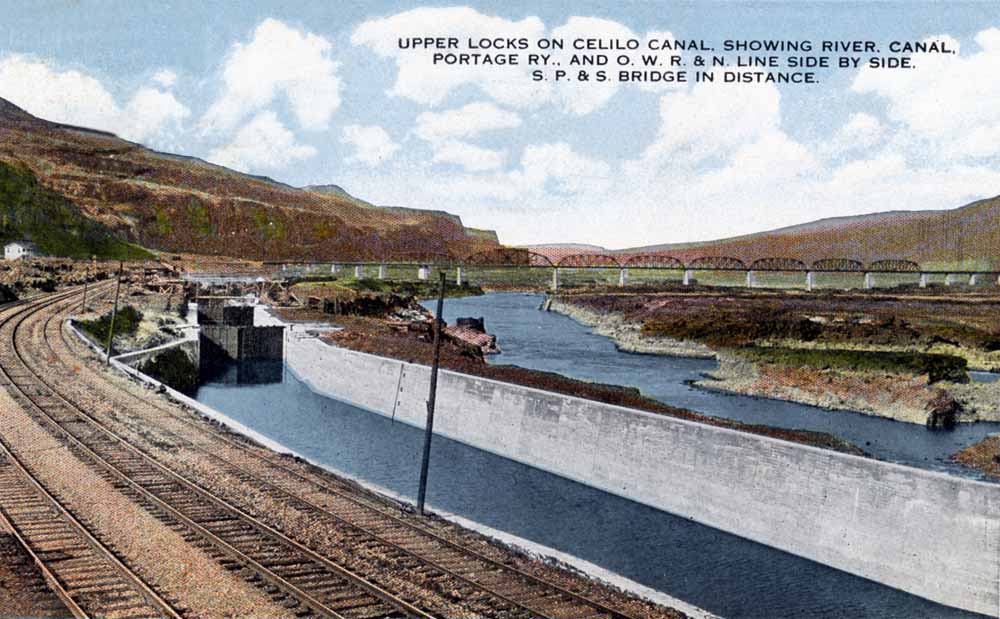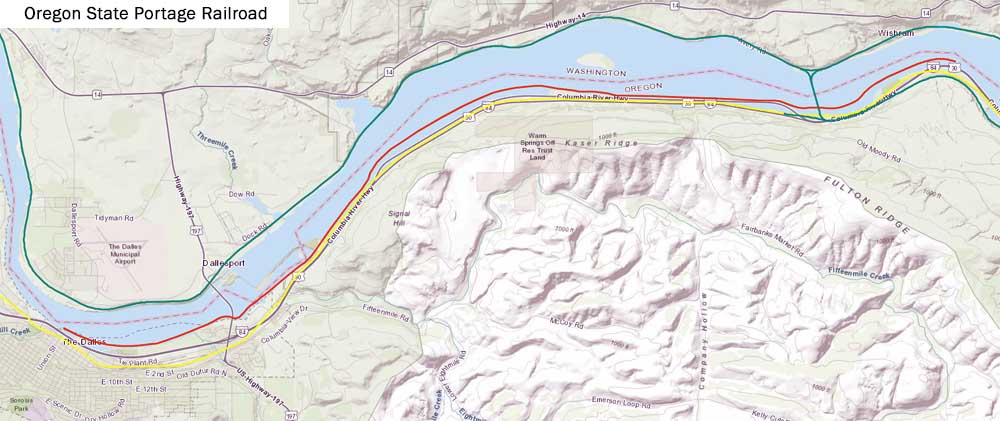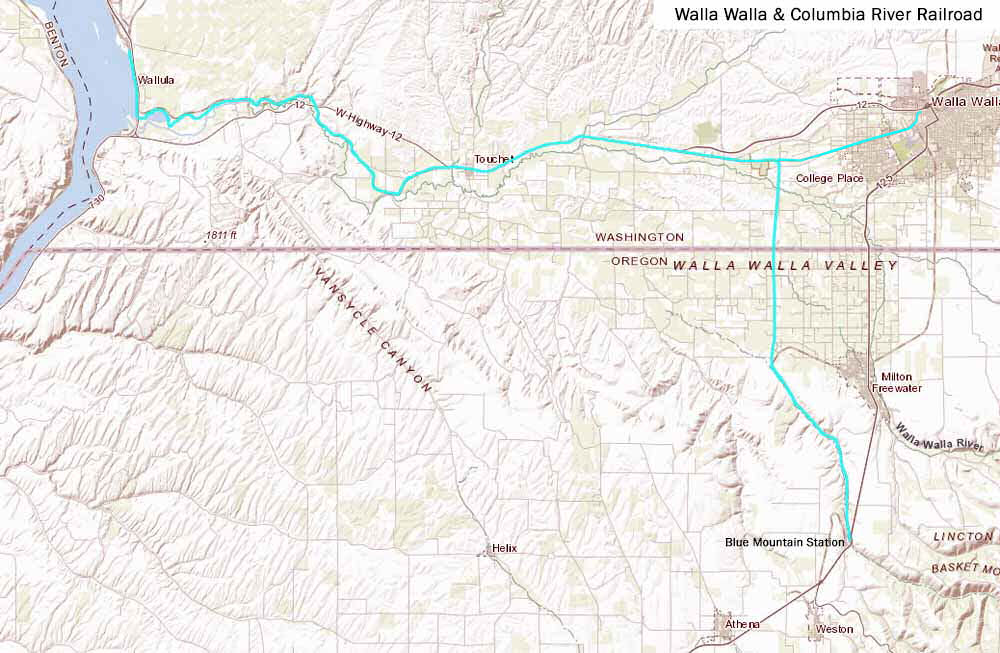|
Other Shortline Railroads |
||||||
|
|
||||||

Postcard view showing the Oregon State Portage Railroad nearest to the river, along with the O-WR&N main line to its left. To the right is the
set of locks the Federal government built to help facilitate river traffic around the Celilo Falls, and visible in the distance is the Oregon Trunk bridge across the
Columbia River. |
||||||
|
|
||||||
|
This page will present information on shortline railroads not fully covered elsewhere on this website. | ||||||
|
|
||||||
|
Oregon State Portage Railroad The completion of the railroad main line along the Oregon bank of the Columbia River seriously threatened the river steamboat business that up to then had enjoyed a virtual monopoly on trade up and down the Columbia. This did not always please a lot of potential and real shippers who now found themselves at the whim of the railroad, and in 1905 a group of Portland based wheat jobbers and wholesalers and another group of famers at the upper end of the river formed the Open River Association. The Association promptly got the Oregon state legislature to approve funds for the Oregon State Portage Railroad, which in 1905 built several miles of portage railroad on the water side of the Oregon Railroad & Navigation Company around Celilo Falls. Additional appropriations allowed the railroad to be extended between 1909 and 1911 west to The Dalles waterfront. The Association and its backers hoped the railroad would provide competition to the railroad, but the old problem of having to unload freight from a boat to railcars on one end of the railroad and then back to boats at the other still made the operation non-competitive with the mainline railroad, and the Oregon State Portage Railroad died a quick death. The Association then got the Federal government to build a canal and locks around Celilo Falls, but that did not prove to be economical either. The entire railroad and the subsequent canal and lock system are now underneath the waters of the reservoir behind The Dalles Dam.  The approximate route of the Oregon State Portage Railroads is depicted by the red line.
|
Walla Walla & Columbia River Railroad |
The Walla Walla & Columbia River Railroad is mentioned in several different sections of this site. The story began around 1860 when the Oregon Steam Navigation Company built some docks at Wallula, Washington, not far north of the Oregon border, designed to serve as the river shipping point for various interests in the Walla Walla Valley and other points in southeastern Washington and northeastern Oregon. A Dr. Dorsey Baker had previously tried building a portage railroad of his own parallel to OSN's portage railroad around Cascade Rapids on the Washington side of the river, only to be thwarted by Captain John Ainsworth. Baker then shifted his gaze east to the Walla Walla Valley, which was having a lot of trouble economically freighting by wagon traffic to and from the Wallula docks, and in 1868 he and some Walla Walla businessmen incorporated the Walla Walla & Columbia River Railroad. After several years of fundraising and organization the WW&CR finally broke ground at Wallula in 1873. By October of that year the railroad had nine miles of completed narrow gauge track, and it hauled its first freight, 24 tons of wheat, to Wallula on 18 October 1873. The railroad as originally built used 5x6 inch timbers topped with iron strips, which were replaced within a couple years by iron rails. The WW&CR finally reached Wallula in 1875, and it operated its first train over the entire line on 6 November of that year. The railroad was immensely profitable from the start, and it provided a necessary service for several years. However, the railroad could not keep from becoming entangled in the rapidly changing world around it. Ainsworth, acting through the Oregon Steam Navigation Company, bought a 6/7th interest in the WW&CR in February 1878, and then he sold that interest along with the OSN company to Henry Villard in 1879. Villard promptly purchased Baker's remaining interest in the WW&CR, but initially kept the short line out of his new Oregon Railway & Navigation Company. Shortly after Villard took control the WW&CR broke ground on a branchline running from Whitman fourteen miles south to Blue Mountain Station in Oregon that opened in 1880, which qualifies the railroad for mention on this site. The railroad would expand one more time, in later 1880 when low water levels seriously impeded navigation on the upper Columbia. To expedite wheat shipments Villard had the WW&CR build its narrow gauge trackage on OR&N's completed grade from Wallula downstream to Umatilla. The railroad operated this line for seven months until the OR&N was in a position to standard gauge the line and commence its own operations. Also in late 1880 Villard had the WW&CR build another twelve miles of track on OR&N grade north of Wallula to a connection with the Northern Pacific, but like the line to Umatilla this line was standard gauged in 1881 and sold to the NP entirely in 1882. The conversion to standard gauge in 1881 also got to the WW&CR main line between Wallula and Walla Walla, which was converted to standard gauge in May 1881. The railroad itself disappeared shortly thereafter when Villard fully merged it into the OR&N. The line to Blue Mountain Station would remain narrow gauge until early 1883, when all but the last six miles were abandoned and replaced with a new line built through Milton. 
|
Eagle Valley Railroad | This shortline probably more properly belongs in the "What Might Have Been" category in as much as it never got beyond initial construction phases. The basic concept for the Eagle Valley Railroad was to extend a line from Baker City northeast into the Eagle Valley. There was a great deal of activity on the proposed railroad in the years immediately after 1900. The railroad was the brainchild of one W.L. Vinson, who in late 1904 incorporated the Eagle Valley Railroad Company with an initial capital stock set at $1,000,000. Baker City's The Spokesman Review reported the following in their edition of 26 January 1905: Surveyors were busy today making the final survey through the city for the Eagle Valley Railway Company, a franchise for which was granted at the last meeting of the city council. Like the Sumpter Valley line, this will be a narrow gauge road, and the rumor has it that for a time repair work will be done at the Sumpter Valley Company's shops. W.L. Vinson, promoter of the Eagle Valley road, gave assurances that the money for building the road has been secured, and that grading will be commenced as soon as the frost is out of the ground. A junction with the O.R.&N. and connection with the Sumpter Valley Railway will be made at this point. One advantage will accrue to the mine operators of Cornucopia and the Seven Devils because it will be narrow gauge and will obviate the necessity of a transfer in shipping to the Sumpter smelter." There were several reports in 1906 that David Eccles, builder of the Sumpter Valley Railway and the Oregon Lumber Company, had taken over the project from Vinson, and at least some of these hinted that the railroad might have been planned at that time to be an electrified railroad. Typical of these reports is the following from the 29 September 1906 edition of The Railway and Engineering Review: "It is reported that David Eccles, president of the Sumpter Valley Ry. and the Odgen & Northwestern, at Ogden, Utah, has announced that he will take over the Eagle Valley Railway project, promoted by W.L. Vinson, and built the road from Baker City, Ore., east to the Snake River, 75 miles. Baker City is reported to be raising a bonus of $100,000 in aid of the road." A 1907 edition of Sunset magazine said the following about the railroad in an article about Baker City: Plans are being constructed for the building of a steam railroad from Baker City to Eagle valley, sixty miles, covering the great copper belt which is being developed, and tapping four hundred million feet of standing timber, all of which will furnish tonnage and passenger traffic, and many pay-rolls. Most of this will directly benefit Baker City, and millions of dollars will be added to the mineral output of Baker county from the great copper belt." Safe to say, construction on the railroad did not begin "as soon as the frost is out of the ground" in 1905. The railroad had however apparently gotten closer to building something in 1908, as indicated by a short news item in The Pacific Monthly, A Magazine of Education and Progress that also identified another sector of the area economy that the railroad would benefit: "Baker City, Oregon- Construction is to be begun at once by the Eagle Valley Railroad Company on their thirty-mile extension into the rich Eagle Valley. This is one of the best producing fruit districts of the West. It has captured a number of world prizes at exhibits, and fruit raising is immensely profitable even now, when the produce must be hauled thirty miles by wagon to market." The 30 January 1909 publication of The Mining World indicated construction had actually commenced: Practically all of what is commonly known as the Eastern Oregon district lies in Baker county, the whole territory being covered by the Blue mountains. Only the outer edges of this mineral belt extend into Wallowa and Union counties on the north, and into Malheur and Harney counties on the south. The belt extends intermittently to the west, however, into Crook county. The Eastern Oregon district was active during 1908, and the close of the year marks a substantial growth and advance in the general condition of things. A number of enterprises have been under way, and not a few completed,, which have done much to solve the troublesome problem of transportation, upon which the profitable working of many of the properties is contingent. The building of the Baker City & Eagle Valley railroad will do more in this regard than any single enterprise that has been promoted in this district for years. Construction work is now in progress on this line, and its completion will mark an important era for Baker county." The railroad actually did break ground in Baker City around 1909 and built about seven miles of grade heading to the east, then climbing up Flagstaff Hill and entering the western edge of Virtue Flat before all work on the project abruptly ceased and was never resumed. If Eccles was still behind the project at that time, he was involved in a great many projects over a vast geographic area and may have simply lacked the capital and focus to push the project any farther than it got. The reserves in the great mining district referenced in the above passages also proved to be not as deep or valuable as first thought, and the mining boom was effectively over by 1910. The Oregon Short Line also built its Homestead Branch north along the Snake River at this same time, which would have put the narrow gauge line at a significant competitive disadvantage had it been built. Two or three miles of the grade can still be seen today winding up Flagstaff Hill next to the state highway, and the Oregon Trail Interpretive Center located at the top of the hill had a trail loop named for the railroad and at least one interpretive sign speaking to its history.
|
|
|